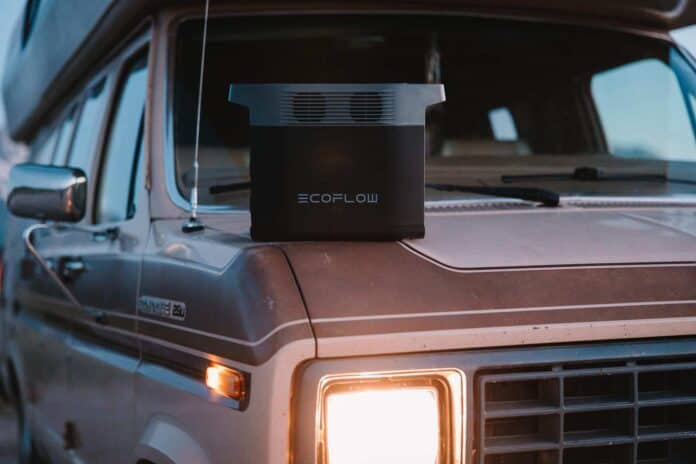Table of Contents
A motorhome gives you the freedom and flexibility to cover your basic needs for shelter and sleeping while venturing around the world. Portable power stations (PPS) offer electricity when and where you need it, whether on a cross-country road trip or parked at a campsite.
Running all your electrical appliances with just the sun’s rays to sustain you is a motorhome owner’s dream. That dream can come true with EcoFlow’s portable power stations. You can turn your PPS into a fully-fledged solar generator if you purchase optional portable solar panels.
If you’ve been searching online for the best portable power solution for your motorhome, you’ve probably noticed the sheer volume of options. We’ve tested and experimented with the top units and are here to provide our list of the best portable power stations for motorhomes in 2024. And we’ve even included a buyer’s guide so you know the specs and features to look for to keep your motorhome powered.
EcoFlow’s Top 4 Portable Power Stations For Motorhomes
Portable power stations are an excellent way to take the power you need with you on the road. Add solar panels, and EcoFlow portable power stations can be powered naturally by harnessing the sun’s energy without worrying about finding a plug to recharge.
Here are the five best portable power stations in 2024:
EcoFlow DELTA 2
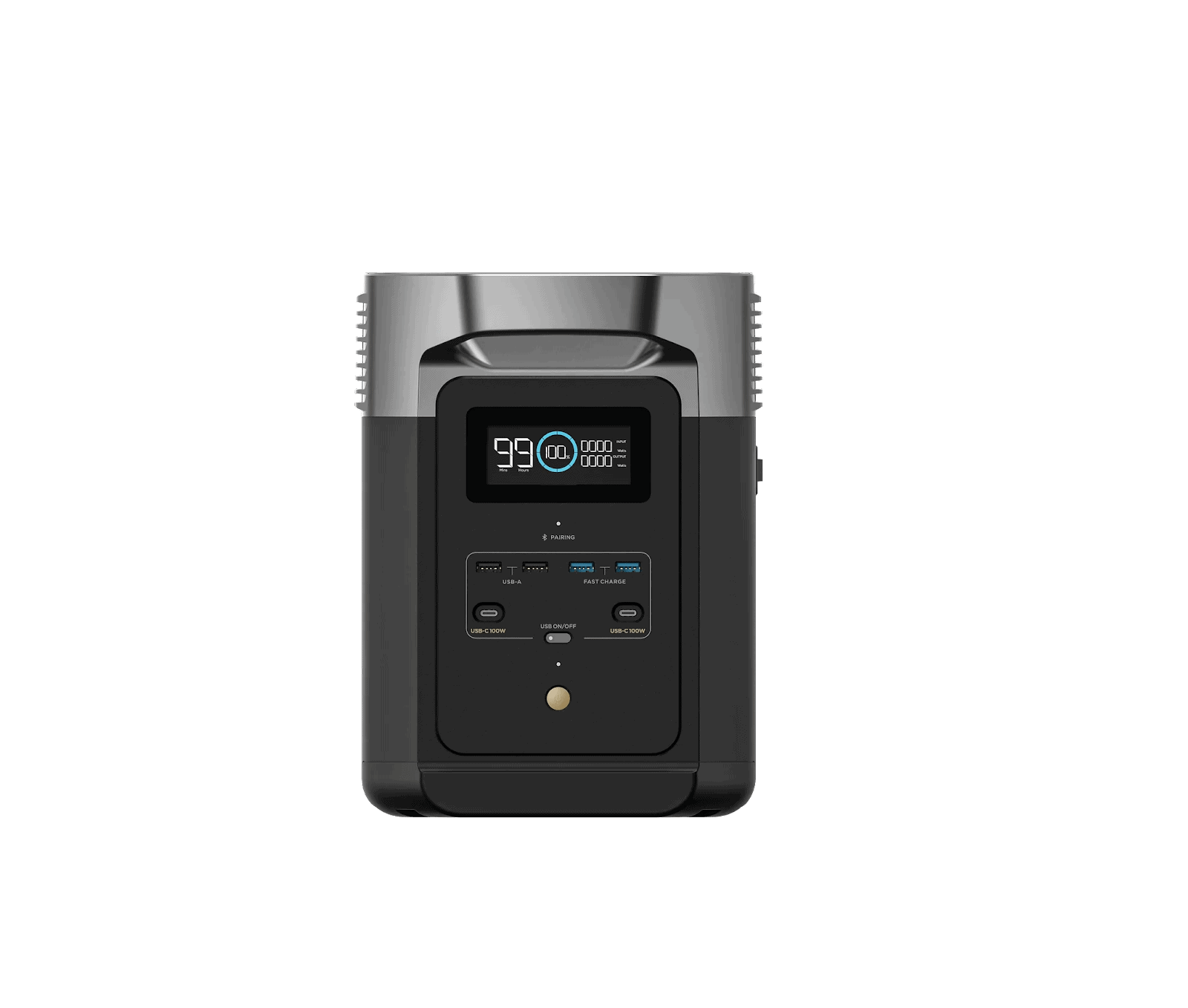
With 1,024Wh and 1800W output capacity, the Ecoflow DELTA 2 has enough power to support over 90% of your home appliances, such as your coffee maker, laptop, TV, electric grill and more. Using X-Boost technology, the output rises to 2200W, making the unit incredibly powerful.
Your motorhome has plenty of devices and appliances that must be running simultaneously. That’s why the DELTA 2 is a great pick. It comes with 15 total ports, including six AC outlets, two 100W USB C ports, one cigarette 12V port, four USB A ports and two C 5521 ports.
Unlike most stations that run on lithium-ion batteries, the DELTA 2 utilises a lithium iron phosphate (LFP) battery. It lasts longer, is more efficient, and is less prone to overheating. The battery allows the unit to run 3000 cycles before losing a small percentage of its total storage capacity.
Specifications:
- Dimensions: 15.7 8.3 x 11 in (400 x 211 x 281 mm)
- Weight: 12kg (27 lbs)
- Recharge time: 1.6 hours (AC), 3-6 hours (1x400W solar panel)
- Capacity: 1024Wh
- Cycle life: 3000 cycles to 80+% capacity
Pros:
- LiFePO4 batteries are long-lasting and offer outstanding durability and efficiency
- Offers WiFi and Bluetooth support
- Lots of ports
- Very lightweight and portable
Cons:
- No dual-charging meaning using the wall and car charger at the same time
EcoFlow DELTA
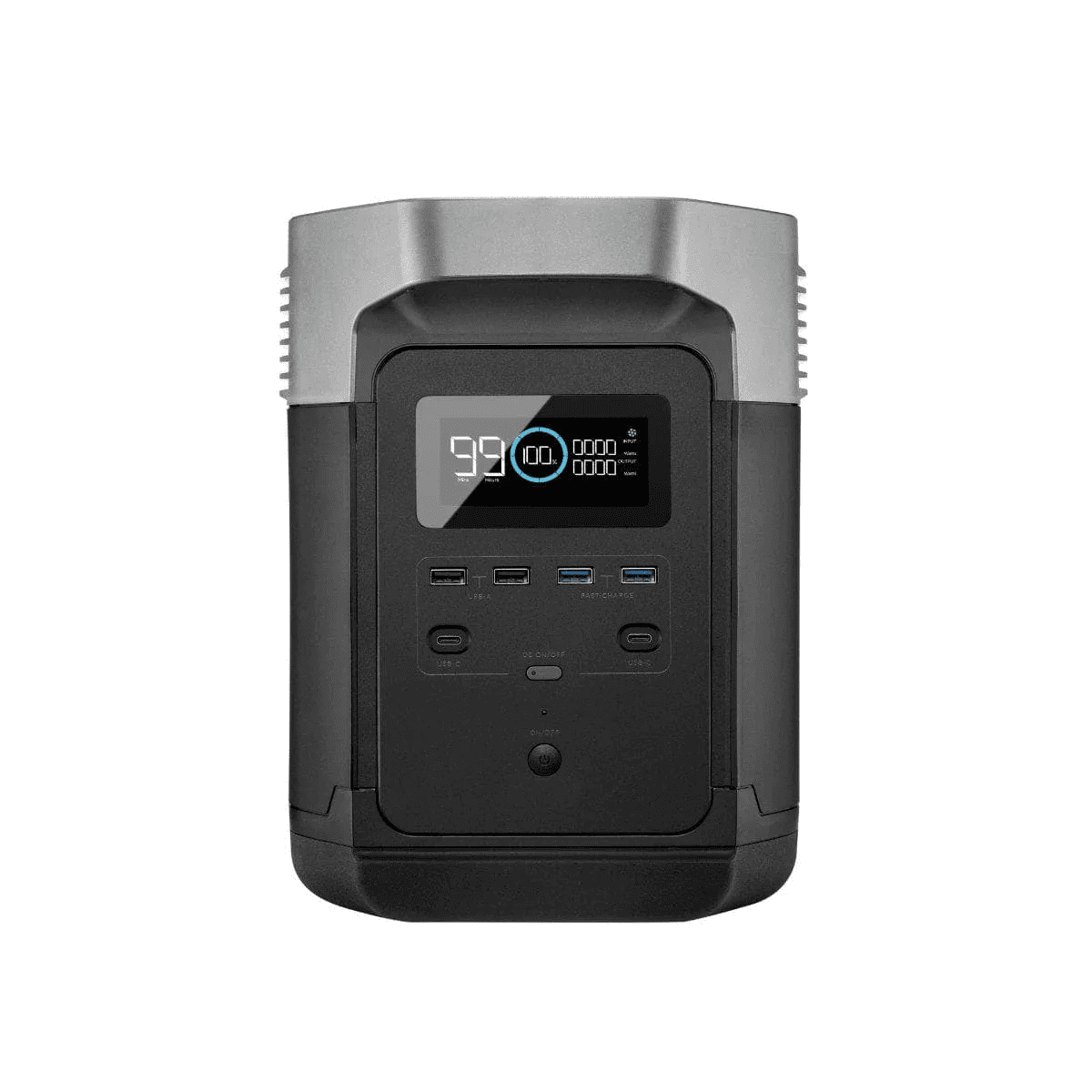
The EcoFlow DELTA is another high-powered system that lets you stay connected on the road. With 21 hours of continuing output, you can keep your appliances and devices nearly all day long before recharging the DELTA. It is perfect for powering appliances that require more prolonged usage, such as refrigerators.
The DELTA lets you power up to 13 devices simultaneously and offers plenty of port types to fit every device. With an output of 1800W and a capacity of 1260Wh, you’re getting even greater storage capacity than the DELTA 2!
Like all EcoFlow products, DELTA has an array of safety features. These include temperature, overcurrent, low voltage, overvoltage and overload protection. As a result, you can expect the ultimate in electrical safety.
Specifications:
- Dimensions: 15.7 x 8.3 x 10.6 in (40 x 21 x 27 cm)
- Weight: 14 kg (30.9 lbs)
- Recharge time: 1.6 hours (AC), 4-8 hours (1x400W solar panel)
- Capacity: 1260Wh (50.4V)
- Cycle life: 800 cycles to 80%+capacity
Pros:
- Enough power to support heavy-duty appliances
- It offers extremely faster charging
- Providers 21 hours of continuous power, enough to power your entire motorhome
- Can power 13 devices at the same time
Cons:
- No status or remote control monitoring
EcoFlow DELTA Pro
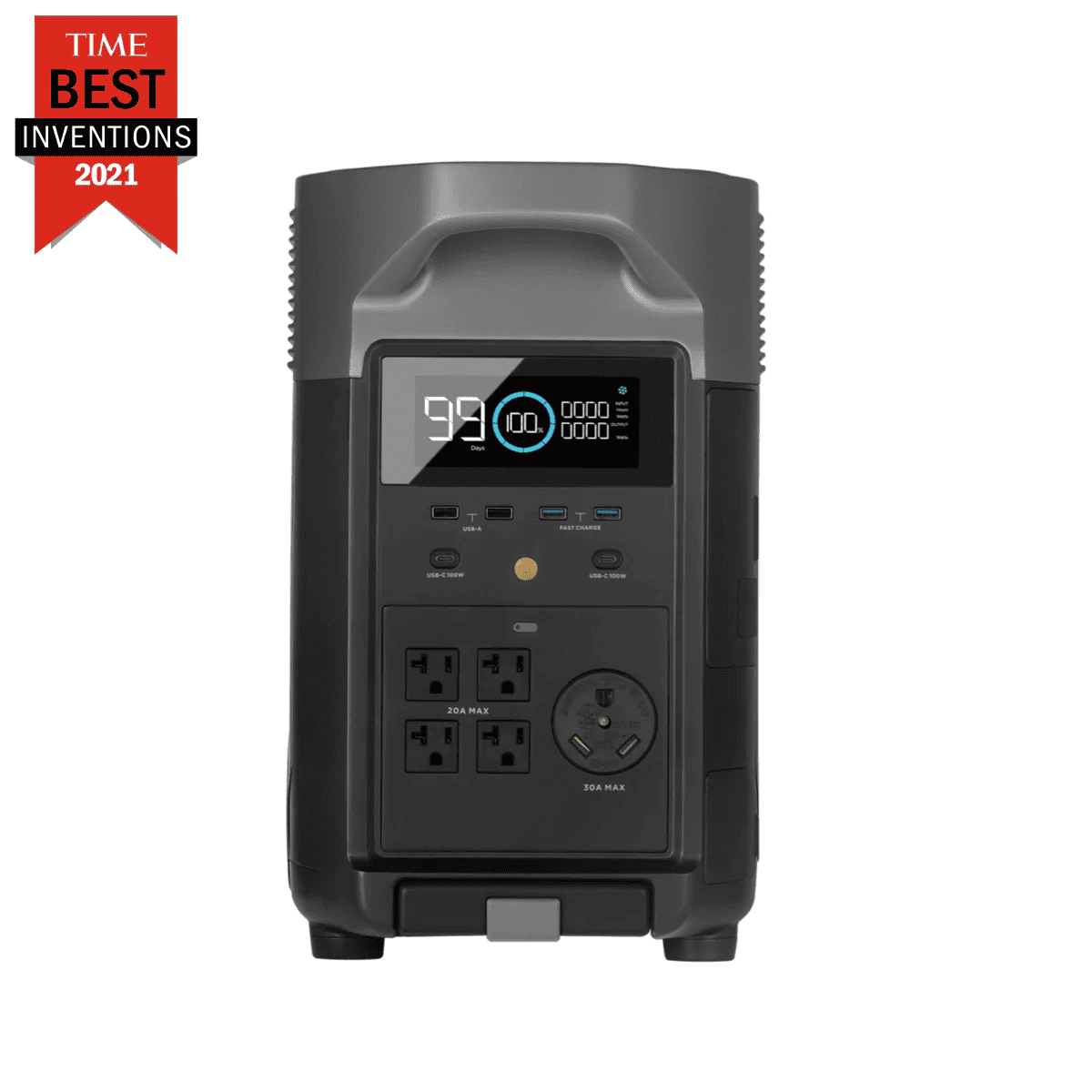
If you’re concerned about power output or battery storage, the EcoFlow DELTA Pro has you covered. It boasts an astounding 3,600Wh, which can expand up to 25kWh. It’s no exaggeration to say you can run your portable power station for many days without recharging the unit. However, to achieve the 25kWh, you’ll need to have six stations running simultaneously.
When you pair two units together, the DELTA Pro features up to a 7200Wh, allowing you to use essentially any appliance imaginable. DELTA Pro has the specs to do the job whether you need your fridge constantly running or to power almost any other heavy-duty appliance.
Specifications:
- Dimensions: 25 x 11.2 x 16.4 in (63.5 x 28.4 x 42 cm)
- Weight: 45 kg (99 lbs)
- Recharge time: 1.8 hours (AC), 2.8 – 5.6 hours (solar panels)
- Capacity: 3600Wh
- Cycle life: 6,500 cycles to 50% capacity and 3,500 cycles to 80% capacity
Pros:
- Long lifecycle and battery lifespan
- Extremely fast charging and can be fully recharged in a few hours
- It offers stackability, letting you expand your power output and battery capacity
- Bluetooth and WiFi connectivity
Cons:
- Quite heavy to lug around, but it does come with wheels
EcoFlow River Pro
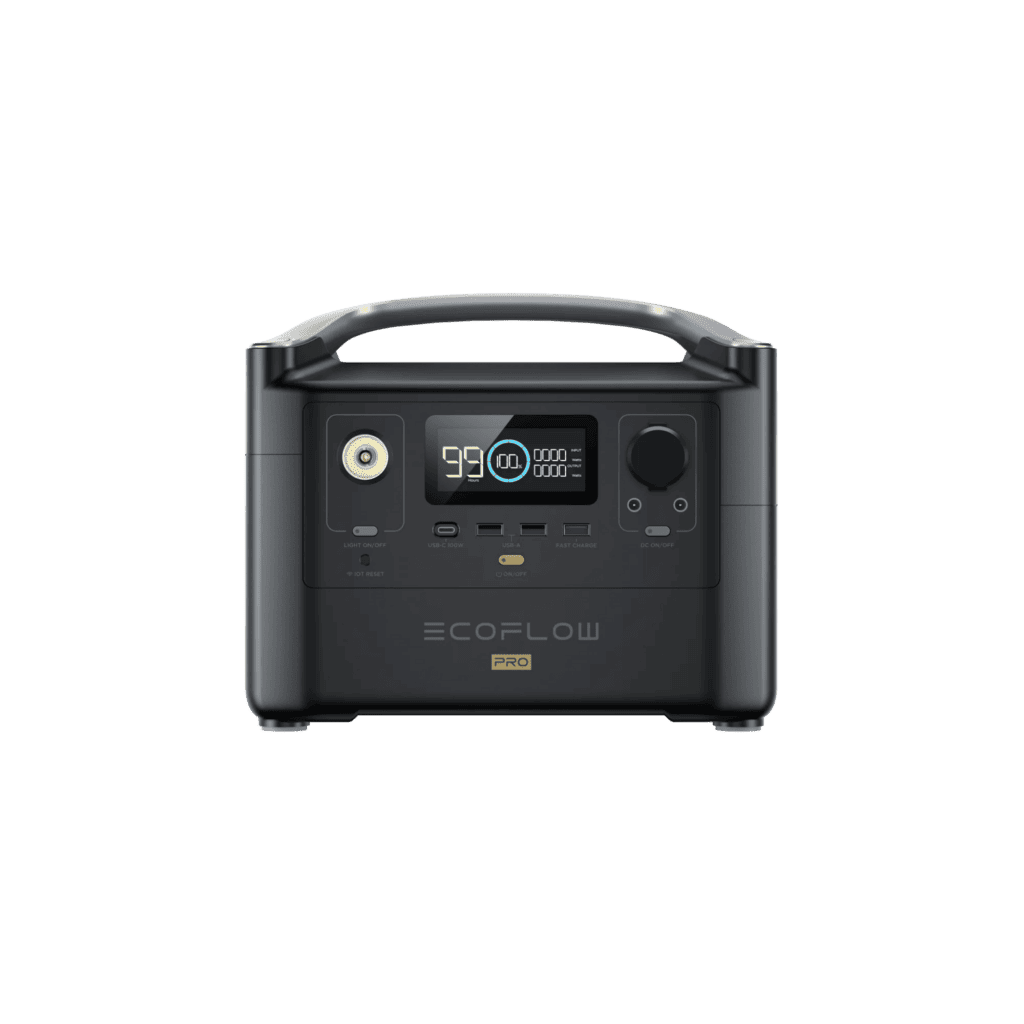
The EcoFlow River Pro is the perfect compact station to enjoy off-the-grid living while powering devices and small appliances. It powers speakers, blenders, laptops, cameras, car fridges, and other smaller devices.
Weighing only 7.6kg (16.8 lbs), you can carry it out of your RV if you plan to camp or stay for extended periods in off-site areas.
This station also offers one of the fastest recharge times at just 70 minutes using the AC charging system. It’ll take as little as three hours to recharge when connected to optional portable solar panels.
- Dimensions: 11.4 x 7.1 x 9.3in (28.9 x 18.0 x 23.5cm)
- Weight: 16.8 lbs (7.6kg)
- Recharge time: 1.6 hours (AC), 4-8 Hours (Using 2x 110W Solar Panels in parallel with direct sunlight)
- Capacity: 720Wh
- Cycle life: 800 cycles to 80+% capacity
Pros:
- Most lightweight and portable option
- Charges in 8 hours with a DC car adapter
Cons:
- Lithium-ion battery offers shorter cycle life than LiFePO4 chemistry
What to Consider When Buying Portable Power Stations for Motorhomes
Depending on your needs, it’s essential to understand the various factors to look for when purchasing your portable power station. You’ll need to look at its overall power output, storage, number of outlets, charging capabilities and other features. We’ll cover each one in more detail.
Portability and Size
Portable power stations are designed to be lighter and smaller than traditional power storage and generator options. However, some units are still pretty bulky. Some weigh under 10 kilograms, while others are over 45 kilograms.
Typically, the more power storage and output the unit can provide, the bigger and heavier it’ll be. The right balance of capacity and portability will depend on your energy consumption needs.
If you’re only powering your motorhome for a weekend trip, you’ll probably only need a lightweight, small, easy-to-handle unit. You’ll need a larger power station if you want to power your fridge and other large appliances.
Recharge Time
Recharge time lets you know how long it’ll take to return a fully discharged power station battery to a full charge. The manufacturer’s documentation should provide an estimate of the charging time based on the specific power input, such as AC charging or solar panels and the charging speed of the battery.
If you use solar panels, the recharge time also depends on their maximum input. Cloudy weather conditions can impact charging, so it’s best to charge your PPS using direct sunlight for optimal results.
A fast charge rate means less downtime waiting for your power station to charge before you can power your devices and appliances.
Adding solar panels gives you a completely off-grid power option, not to mention the other potential benefits, such as contributing to a greener planet and possible support from government programmes.
Just keep in mind that portable power stations don’t come with solar panels. You’ll need to purchase them separately or upgrade to a solar generator to bundle and save.
Power Output
The power output is the total amount of electricity the PPS can generate at one time. Output is typically measured in watts. There are two measurements for power output: continuous output and peak output.
Continuous output is the wattage delivered on an ongoing basis, whereas peak output is the highest safe wattage produced in a short time.
Appliances like refrigerators and AC units use way more power to turn on initially than when running, so a high peak rating lets you start up larger devices safely.
It’s always best to check the wattage of each appliance and device you’re planning to connect to your power station to ensure adequate power output capacity. If you need multiple devices plugged in simultaneously, add those wattages up to determine your total energy consumption needs.
Number and Types of Ports
Portable power stations will vary in the number of available outlets. Some units can have as few as two outlets, while others boast over eight. It’s crucial to figure out how many devices you plan on charging or running simultaneously to estimate the number of outlets you need.
The types of ports included in the power stations allow you to connect to a wide variety of devices. Many units have a variety of ports, such as USB-A and USB-C ports, 230-volt outlets, 12-volt barrel connectors and 12-volt accessory ports.
The variety of ports is crucial, especially depending on which devices you use. For example, laptops and smartphones tend to use UBC-C ports to charge. If you wish to use a portable power station for motorhomes, we recommend finding one that offers AC, USB and DC charging options.
Battery Type
Battery type is another important consideration when deciding on power stations. Lithium-ion batteries tend to store more power, come in smaller sizes and last longer than traditional lead acid batteries. Furthermore, they’re lightweight and can take up to 80 or 90% deep discharges without losing capacity over time.
An upgrade from lithium-ion batteries are LFP batteries. Also known as a LiFePO4 battery, LFPs boast even longer life cycles. You can fully charge and discharge the battery many more times, which is incredibly useful for motorhome usage.
Extra Features
Modern portable power stations have additional features such as:
- Multiple recharge options: Many power stations can recharge with numerous options such as from their car charger, AC charging or solar panels. Since solar panels take longer, it can be helpful to use AC charging for a quicker recharge when available.
- LCD: An LCD allows you to monitor the amount of power your unit is generating and how much charge remains in PPS.
- Wireless connectivity: A portable power station with a Bluetooth or WiFi app lets you easily monitor power input and consumption on your mobile device. WiFi is the best wireless connectivity option since you can monitor the unit from anywhere with an internet signal, whereas Bluetooth requires you to be in close range.
Conclusion
A portable power station can be the ideal solution to run your motorhome’s appliances and devices as you venture off and spend time outdoors.
When purchasing a portable power station, it’s essential to consider the portability, durability and battery storage capacity.
We’ve saved you the hassle of scouring thousands of reviews online by carefully curating the best portable power stations and providing you with their pros and cons. Consider the five choices reviewed above and your power consumption needs to help you make the right decision.
